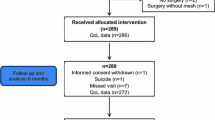Abstract
Purpose
The aim of this study is to present long-term results including patients’ satisfaction, pelvic floor symptoms, regret and change in body image in a long-term follow-up after colpocleisis.
Methods
All women who underwent colpocleisis between September 2001 and February 2014 were identified from the hospital operating lists. These women were contacted for a telephone survey up to 13 years after surgery and asked to complete a structured questionnaire to assess patients’ satisfaction, Quality of Life (QoL) and pelvic floor symptoms.
Results
A total of 44 women underwent colpocleisis during the period from September 2001 to February 2014. Mean age was 78 years (range 65–91) years. Mean follow-up time was 41 months (range 10–120). Twenty women could be reached for the survey and were included in the analysis. 15 (75 %) reported a positive impact on QoL, 2 (10 %) a negative because of urinary problems, 2 (10 %) could not report any change in the QoL and 1 (5 %) could not answer this question. There was no recurrence of prolapse. The majority of patients (90 %) would undergo the same surgery again and no patient regretted the loss of her vaginal sexual function.
Conclusions
Colpocleisis seems to be an effective treatment for pelvic organ prolapse. In the long term, impact on quality of life is positive, whilst urinary tract symptoms seem to be the most bothersome factor.

Similar content being viewed by others
References
Jelovsek JE, Maher C, Barber MD (2007) Pelvic organ prolapse. Lancet 369(9566):1027–1038
FitzGerald MP, Richter HE, Siddique S, Thompson P, Zyczynski H, Weber A (2006) Colpocleisis: a review. Int Urogynecol J 17:261–271
Abbasy S, Kenton K (2010) Obliterative procedures for pelvic organ prolapse. Clin Obstet Gynecol 53:86–98
Skoczylas LC, Turner LC, Wang L, Winger DG, Shepherd JP (2014) Changes in prolapse surgery trends relative to FDA notifications regarding vaginal mesh Int Urogynecol J 25:471–477
Misrai V, Gosseine PN, Costa P, Haab F, Delmas V (2009) Colpocleisis: indications, technique and results. Prog Urol 19(13):1031–1036
Wei JT, Nygaard I, Richter HE, Nager CW, Barber MD, Kenton K et al (2012) A midurethral sling to reduce incontinence after vaginal prolapse repair. N Engl J Med 366(25):2358–2367
Zebede S, Smith A, Plowright L, Hegde A, Aguilar V, Davila W (2013) Obliterative LeFort colpocleisis in a large group of elderly women. Obstet Gynecol 121:279–284
Reisenauer C, Oberlechner E, Schoenfisch B, Wallwiener D, Huebner M (2013) Modified LeFort colpocleisis: clinical outcome and patient satisfaction. Arch Gynecol Obstet 288:1349–1353
Vij M, Bombieri A, Dua A, Freeman R (2014) Long-term follow-up after colpocleisis: regret, bowel and bladder function. Int Urogynecol J 25(6):811–815. doi:10.1007/s00192-013-2296-3
Koski M, Chow D, Bedestani A, Togami J, Chesson R, Winters C (2012) Colpocleisis for advanced pelvic organ prolapse. Urology 80:542–546
Boyles S, Weber A, Meyer A, Meyn L (2003) Procedures for pelvic organ prolapse in the United States 1979–1999. Am J Obstet Gynecol 188:108–115
Lindau ST, Schumm LP, Laumann EO et al (2007) A study of sexuality and health among older adults in United States. N Engl J Med 357:762–774
Crisp C, Book N, Smith A, Cunkelman J, Mishan V, Treszezamsky A, Adams S, Apostolis C, Lowenstein L, Pauls R (2013) Body image, regret and satisfaction following colpocleisis. Am J Obstet Gynecol 209:473 (e1–7)
Mothes AR, Radosa MP, Altendorf-Hofmann A (2016) Runnebaum IB Risk index for pelvic organ prolapse based on established individual risk factor. Arch Obstet Gynecol 293:617–624
Author information
Authors and Affiliations
Corresponding author
Ethics declarations
Funding
No funding.
Conflict of interest
None.
Ethical approval
All procedures performed in the study were in accordance with the ethical standards of the institutional and/or national research committee and with the 1964 Helsinki declaration and its later amendments or comparable ethical standards.
Informed consent
Informed consent was obtained from all individual participants included in the study
Rights and permissions
About this article
Cite this article
Katsara, A., Wight, E., Heinzelmann-Schwarz, V. et al. Long-term quality of life, satisfaction, pelvic floor symptoms and regret after colpocleisis. Arch Gynecol Obstet 294, 999–1003 (2016). https://doi.org/10.1007/s00404-016-4158-y
Received:
Accepted:
Published:
Issue Date:
DOI: https://doi.org/10.1007/s00404-016-4158-y



